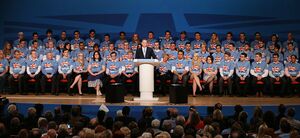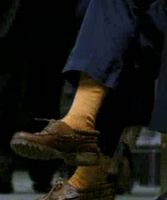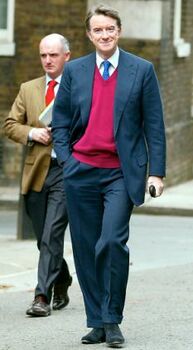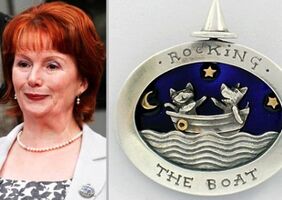Westminster Style
Being in politics means being constantly in the public eye, and it is important to choose clothes that give the right impression when you're out trying to win support. In the 18th Century, a uniform of breeches, tights and powdered wigs was perfectly acceptable, but this would be frowned upon in the 21st Century. Even in the House of Lords.
There is no political "uniform", except for when receiving a peerage, or when you have another formal duty in the State Opening of Parliament. Otherwise, the basic "suit, shirt/blouse and tie" can be altered and accessorised as an expression of one's personal style. Quality of suits can vary. A well-dressed Cabinet Minister who may or may not have a history in the City will wear a well-cut Turnbull & Asser or Ozwald Boateng number, but a savvy MP may want to appear less absurdly rich may wear much cheaper high street suits that haven't been tailored for them.
Uniforms[edit | edit source]
Speaker[edit | edit source]
The Speaker of the House traditionally wore a wig with black robes, adorned with a train and mourning rosette. At state openings of Parliament, they would wear gold-trimmed robes and a tricorn hat. Until recently, Speakers would wear breeches, silk stockings and buckled shoes. Speaker Bercow has done away with tradition, and only wears his black robe. However, knowing his wife, it is possible that he still wears silk stockings and a tricorn hat under other circumstances.
Opening of Parliament[edit | edit source]

The Queen wears her robes of state and Imperial State Crown for the Opening of Parliament. She is accompanied by the Lord Chamberlain, carrying the sword of state, the Leader of the House of Lords, carrying the Cap of Maintenance, and then Black Rod (generally a respected military figure). These men and women will be dressed in ceremonial robes.
Peers wear their ceremonial robes. Most of the House of Lords is comprised of holders of baroncies. They wear scarlet wool robes with three ermine bars, lined with gold leaf lace. These days they wear normal suits beneath their robes, unlike before, when they wore Slave Leia bikinis or Borat mankinis (abolished when John Prescott was given a peerage as part of New Labour's House of Lords reforms).
Prime Minister[edit | edit source]
The Prime Minister is not obliged to wear any particular robe. However, both Tony Blair and David Cameron have embraced the 'Number 10' football shirt.
Tories[edit | edit source]
Traditionally, Tories have been associated with tweed, Bullingdon tails or silk waistcoats. An example of a stylish historical Tory is Benjamin Disraeli, who wore colourful velvet and had dandyish, curly hair. However, the Bertie Wooster look is no longer acceptable, and Tory MPs often go to lengths to appear middle-middle class, buying suits that are not bespoke (see above), accessorized with a blue-ish tie, and dressing in dark-wash jeans during constituency events (light-wash jeans are too closely associated with New Labour).
The style of the Tory youth varies. Some try to recapture the 'good old English way', wearing green wellies, (even if they live in urban areas), gilets, and Jack Wills from head-to-toe. They plaster the windows of their first cars with Countryside Alliance stickers, (even if they've never sat on a horse in their life). Others/most are less pretentious.
Specific Tory Trends[edit | edit source]
Margaret Thatcher, despite being a cross-dresser in Spitting Image, dressed in a feminine style, and was notable for her pussy-bow blouses, pearl necklaces, court shoes and her infamous black handbag. Her handbag, which was present on the table at every Cabinet meeting was described as a "symbol of her power over the men in her Cabinet". She wore her blonde hair in a voluminous bouffant. She loathed facial hair on men, declaring that she wouldn't have a single beard around her Cabinet table, possibly because they are associated with Socialists, but also possibly because they are ugly.
During the 1980s and 1990s, many Tories wore enormous glasses, including Geoffrey Howe, Norman Fowler, Douglas Hurd and John Major. It is not obvious why, other than perhaps they believed that it made them look more intellectual. Jack Straw of Labour continued the trend into the Noughties.
Ken Clarke always wears Hush Puppies, and crumpled suits. Michael Heseltine had a very notable hairstyle - straw blonde and long. It is now in exactly the same style, except it has silvered to an attractive grey. He had a habit of sweeping it back, which was parodied in Spitting Image. Douglas Hurd was notable for his 'Mr Whippy' hairstyle - white, and plastered into neat waves on his head, which was also parodied in Spitting Image.
Of the modern Tories, Theresa May has a famously sharp mind, and compliments this with a very sharp wardrobe, circulating between a number of modern, stylish jackets, including her famous 'space suit' jacket, animal prints, bold floral prints, real leather and metallic fabric. She usually wears stiletto heels.
Michael Gove is married to a style journalist, Sarah Vine, who claimed in the Times that she knew she wanted to marry him when she realised that he matched his dressing gown with his PJs.
A modern Tory should be caught by photographers accessorising their reasonably priced suit and blue-toned tie with a baby in a baby harness, a beer, a wife and a bulging Tesco bag (Waitrose bag hidden inside)
William Hague's sartorial choices were mocked during his tenure as leader of the Conservative Party, wearing a "HAGUE" baseball cap to hide his red, balding hair. He was recently photographed repeating this awful experiment.
Labour[edit | edit source]
Your typical Old Labourite will be caught wearing a moleskin or tweed suit that is possibly mouldy or patched at the elbows, a red tie and brown shoes. Charlie Whelan always wore tweed, while Dennis Skinner always wears tweed with a red tie. While cigars are very Tory, old Labourites should feel comfortable smoking a pipe.
If you must wear glasses, make sure that they are round with thick rims - much like Clement Attlee's, Herbert Morrison's or Ernest Bevin's - they will make you look like you got them in the early days of the NHS.
While Young Labourites dress normally in knits and jeans, many Young Socialists have a very particular dress code. They must wear the same shoes until they fall to pieces, because buying new shoes is the first sign of surrendering to consumerism. They should grow beards as soon as possible, and have an over-the-shoulder satchel at the ready, stuffed full of activist flyers to hand to bewildered people in the street.
Herbert Morrison was notable for his trademark quiff. He was very aware of his image as a Cockney in the media and worked with satirical artist Sir David Low to perfect his public persona - artfully rumpling his suits before going to speak.
The early Labourite Prime Ministers sported moustaches - Ramsay MacDonald and Clement Attlee, though moustaches in the Labour Party have faded into nothingness now, and the current Labour lineup is very clean-shaven.
Michael Foot was notorious for wearing what looked like a Donkey Jacket while laying his memorial wreath, and had a Socialist attitude to his hair, letting it grow out messily.
Neil Kinnock was neurotic about having freshly polished shoes, and consistently wore a diagonally striped tie. His deputy, Roy Hattersley, wore loud shirts and waistcoats, having a relatively good sense of style for a Labour politician of the 1980s. Their spin doctor, Peter Mandelson, would rarely wear a suit while working at Walworth Road, instead wearing v-necked jumpers, jeans, a moustache and famously colourful socks. Neil Kinnock strongly disliked his socks, saying, in a rather agitated tone atfter Peter's interview I know he's... that way, but does he have to flaunt it? He introduced the red rose, which came to be worn in the buttonholes of candidates during election campaigns in 1987, 1992, 1997, 2001 and 2005.
The New Labour years brought about a significant style revolution to the Party. For weekends and casual events, football shirts and pale blue jeans were encouraged. Dark suits with red ties were the norm when in Parliament.
Tony Blair had no taste outside of his reasonably well-cut suits, and even then he often worn lemon yellow or bright blue shirts underneath them. He was reported by Alastair Campbell as having worn lime green polka dot underpants, Afghan jackets and tasseled accessories. Gordon Brown stuck to the uniform of black suit, white shirt and red tie - even getting married in his usual dress. Peter Mandelson, in the later New Labour years, gave up the nondescript black suits to indulge his inner peacock, and began wearing double breasted and pinstriped suits in silver, beige and jewel-toned blue, teamed with jumpers in various colours, woolly scarves, white, pink or purple shirts and pink socks.
Ben Bradshaw is also fiendishly stylish, here wearing a black fedora with a black overcoat, but stops himself delving too far into mafia-chic with a candyfloss-pink scarf.
Jack Straw also explored the world of hat-dom when he wore his 'Grim Reaper' outfit (dubbed as such by the media and allegedly the Prime Minister) to inform Gordon Brown that he was doing a terrible job as Prime Minister. Chris Bryant has been photographed wearing a blue gingham shirt, and was photographed by himself wearing a pair of unattractive Y-fronts. He probably needs to spend some time with Ben Bradshaw to learn how to dress.
Of the women, Harriet Harman wears a usual combination of dark trousers, flat shoes, a top rather than blouse, bulky plastic beads and usually a patterned jacket. She has worn a number of interesting prints, and is thus likely to be in fierce competition with Theresa May for the 'most eye-watering jacket in Parliament' award. Her wardrobe has included; traffic cone orange, Barbie pink, a very loud BW floral print and best of all, giraffe:
Yvette Cooper broke convention by getting married in a blue velvet dress with a sculpted collar and a mermaid skirt, rather than the usual white. She normally wears a top, like Harriet, though she is more likely to wear a skirt. She wears her legs bare or with nude tights, and is inclined towards loafers rather than high heels.
Hazel Blears infamously accessorised her resignation outfit with a brooch with the words "rocking the boat", which she later apologised for.
Caroline Flint was one of the more girlish dressers of recent female Cabinet ministers, wearing short, figure-hugging skirts, high heels, and posing in plunging dresses for photographs. She was nicknamed "Minister for Short Skirts" by the tabloids and eventually resigned, saying that she was sick of being treated as "window dressing".
Liberals and Liberal Democrats[edit | edit source]
William Gladstone, the most famous Liberal of them all, was famously rumpled and styleless, but the subsequent generations have held up in the style rankings more effectively than they have done in the polls. A modern, Orange Book Lib Dem going into Parliament should dress in a well-tailored suit, with an orange or yellow tie, or a neutral blouse, coloured jacket and black skirt or trousers for women.
Younger or more left-leaning Lib Dems, particularly students, should try wearing sandals (not hemp), ironic t-shirts, rubber charity bracelets and adorning their lapels or satchels with slogan badges saying things like 'LIB DEMS AGAINST FEES', 'WE TRUSTED YOU NICK' or something about Iraq or staying yellow. Girls can wear gypsy skirts and their hair is often unstyled, whether long and uncombed or cropped.
David Steel was notable for his fondness towards striped shirts with white collars, which was parodied on Spitting Image.
Of the Liberal Democrats, Nick Clegg is notable for the golden tie worn during the first two Leaders' Debates of the 2010 general election, dubbed the 'gold lame disco tie' by Times columnist Caitlin Moran. Vince Cable, like Jack Straw, has experimented by wearing a black trilby in public.




















